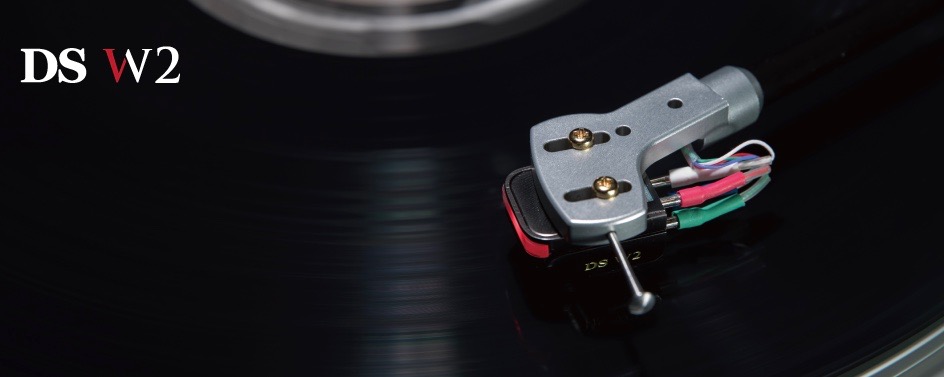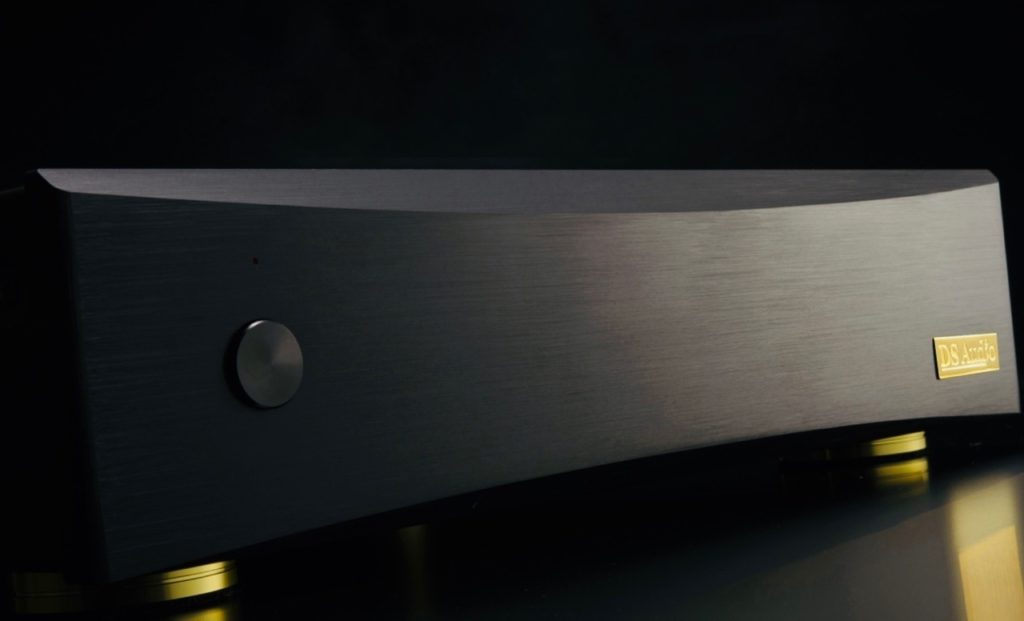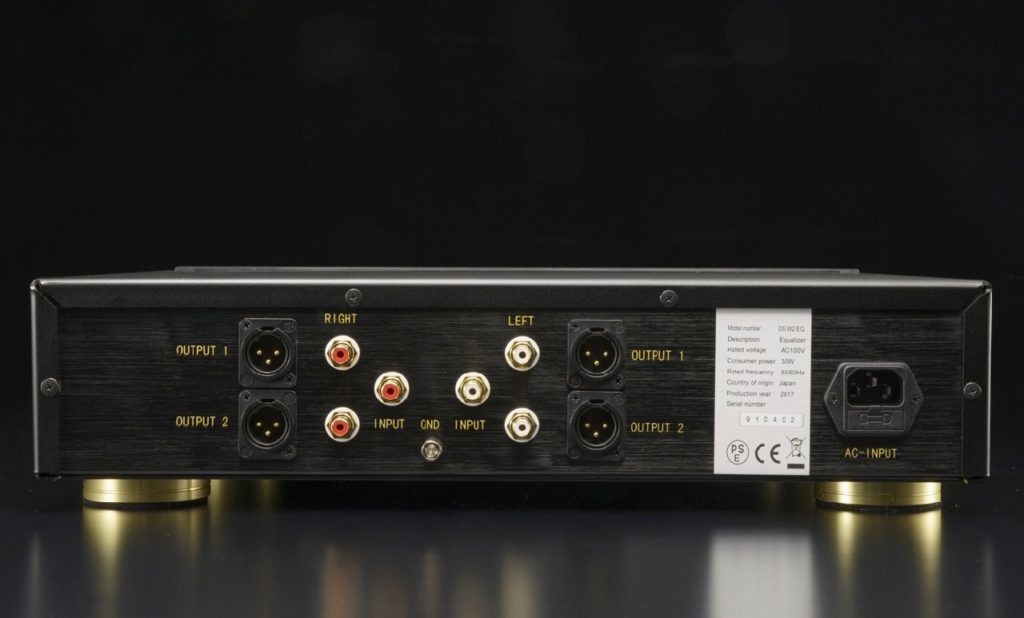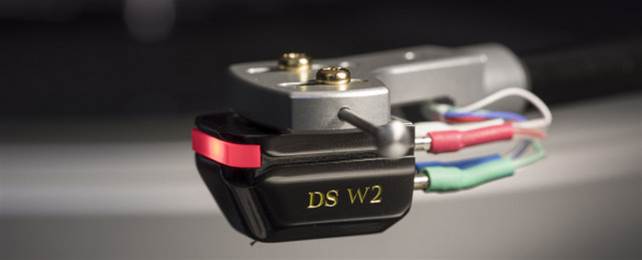
Back in the spring of 2016, I did a review of the DS Audio DS-W1 Optical Phono Cartridge with its Preamp/Equalizer ($8,500) and immediately fell in love with it. If you want to know more about the history of the optical phono cartridge and how the DS Audio Optical cartridges work, click here to read Part One of my DS-W1 review on Dagogo.
One year later, I reviewed the DS Audio DS-Master1 Optical Phono Cartridge ($22,500) with its massive 52-pound Phono/Equalizer. The sound was far more musical than I had ever heard from LPs, in fact so much so that I purchased the DS-Master1. In January of this year, I reviewed the bargain of the DS Audio Optical Phono Cartridges, the DS-002 with its Phono/Equalizer ($5,500).
The Master1 and DS-002 both share a newly-designed micro-optic generator design, with the the shutter positioned closer to the stylus, resulting in a shorter optical signal path. They also use the new wire-suspended cantilever. These changes create significant improvements in channel separation over the DS-W1 and are found in the DS-W2. Neither of them have the Boron cantilever of the DS-W1. The Master1 has a sapphire cantilever, and the DS-002 has an aluminum cantilever.
While the Master1 and DS-002 are the two best cartridges I have heard in my system, I still wondered what a Master1 cartridge would sound like with a Boron cantilever. I loved the touch of warmth that the DS-W1 had. I wondered if that warmth could be had in the Master1 without the Master1 losing any of its magic.

Well, now there is the DS Audio DS-W2 with its own 26-pound Preamp/Equalizer ($13,000 with the W2 cartridge at $4,500 and the equalizer at $8,500). With it, you get an optical cartridge with a Boron cantilever and a micro-ridge stylus that has a minimum curvature radius. What you don’t get is a cartridge body made of what they call “Ultra” duralumin. Instead, the body is made of aluminum. So, expect a follow-up article on the DS-W2 cartridge, but for now, I’ll get on with my review of the DS-W2 with the aluminum body. One thing that DS Audio wants to be sure you understand is that all of the DS Optical phono cartridges are entirely analog devices. All you have to do is listen to any of them to know this is true.
With the introduction of the DS-W2, DS Audio once again has three optical cartridges and three Preamp/Equalizers that all work with one another. This makes it possible to move up in the line in steps, or to find the combination that is right for your ears and your pocketbook. A little birdie tells me that there will most likely be a trade-in path to help owners move up the line.
The biggest visual change from the DS-W1 to the DS-W2 is the Preamp/Equalizer. To start with, the DS-W2’s Preamp/Equalizer is about three times the size and weight of the DS-W1’s. This makes it closer in size to the Master1’s Preamp/Equalizer than to the DS-002 Preamp/Equalizer. The DS-W2 has two sets of single-ended RCA outputs and two sets of balanced XLR outputs. Output 1 is the “DS Standard” single cut-off with 6db/octave at 30Hz while output 2 is “RIAA Standard” double cut-off with 6db/octave 50.5Hz and 6db/octave at 30Hz. It does not have the third output 3 of the Master1, which is a triple cut-off with 6db/octave 50.5Hz, 6db/octave at 30Hz and 12db/octave at 25Hz. This was one of the best choices they could have made to save a little on the price. I have tried all of the different outputs on each unit I have reviewed, and in every case, I have preferred the RIAA setting by a large margin.

Cartridge Set Up
All cartridges need to be set up correctly to sound their best, and that seems obvious. The point should be made that some phono cartridges are more particular than others about how they are set up. For example, phono cartridges with a conical stylus are not as fussy about set up. When it comes to a cartridge with a micro-ridge stylus, proper setup is critical. In a displacement reading cartridge, the set up of the azimuth and anti-skating is particularly important. One other thing to know about a displacement reading cartridge with a micro-ridge stylus is that it is even more important to set everything up precisely and to keep the stylus clean.
Review System and Description
I used my reference system for this review. My system consists of my AMG V12 turntable with their 12-inch Turbo tone arm placed on an HRS M3X-1921-AMG isolation platform made for the V12. I used my Emia Remote Attenuator as the line stage, and the power amp for the review was the First Watt SIT 3. I used my Teresonic Ingenium XR Silver speakers.
So, the DS-W2, which is the replacement for the DS-W1, is the fourth DS Audio cartridge I have reviewed. The W2 has a couple of things going against it that have nothing to do with its sound, performance or value. First it’s not the least expensive or the most expensive of the DS Audio Optical cartridge systems.
Now, this may seem odd to you because it sure does to me, but it’s an observation I have made over many years. There are almost as many audiophiles who are looking for the bargain as there are those who are looking for the component. Then, there are the audiophiles who truly want the very best and will somehow come up with the funds to get it. I’ll give one example. About 18 years ago, a friend of mine opened a retail high-end audio shop. One of the lines he carried was Audio Note UK. Back then, the least expensive AN-E speaker was around $1,500, and the most expensive was around $25,000. He sold a good many of the least expensive ones and a few more of the top of the line ones. As far as I know, I was the only one who purchased a pair of the middle-of-the-line ones. After listening, I thought the sweet spot was the $8,000 pair. I don’t understand why more people don’t try to figure out which product is the one that gives them the most for the dollar they can afford instead of complaining about the most expensive products.
The second concern is that they named it the DS-W2. This is not an improved version of the DS-W1. The only thing left from the DS-W1 is a Boron cantilever. The W1 Preamp/Equalizer weighed 12 pounds where the DS-W2 one weighs double that. The DS-W2 also looks much more like a high-end audio product. There were people who saw the DS-W1 as a great but flawed product; I wasn’t one of them, but I can tell you the DS-W2 has very few if any, flaws.
Listening
In my review of the DS-W, I was blown away by “how it was all about pure fidelity and great harmonics played with rich and beautiful tonal color. It has a natural and realistic warmth without giving up speed or detail. It had a temporal realism that is closer to live music than I have heard before.” When I heard the DS-Master1, I said, “To be honest, I wasn’t prepared for the sound of this phono playback system. I mean, after spending three years listening to the incredible Soundsmith SG-220 Strain Gauge and then the last eleven months with the DS-W1 Optical, I thought I had a handle on what a vinyl playback system was capable of. Not only was I surprised, but I also must admit it’s going to be hard to adequately describe what the DS Master1 cartridge and phono preamp did for my system.” With the DS-002 I said, “The DS 002 is wonderful. It ranks just behind Master1.”
So, it was easy to be awed by the W1 as it was the first optical cartridge I reviewed, and then I was simply amazed at the value of the DS-002. These were the two best cartridges I had heard in my system. I’m sharing all of this because for me it was hard for me to get as excited about the new W2 since I was now was very familiar with the sound of DS-Audio optical cartridge system. Still, there is something very exciting about the W2; it sounds much more like the Master1 than I would have expected. So, I decided to contrast the sound of the Master1 and the W2 by listening to the same LPs I had listened to for the Master1 review.
That means we will start with one of my favorite albums, Joan Baez’s live album From Every Stage. On “Swing Low, Sweet Chariot” with the Master1, the sound was unbelievably alive and open with a holographic, three-dimensional soundstage. It had incredible spatial information and an ease about it. By comparison, the W2 was very close in sound but not quite as alive sounding but more so than the DS-002.
Baez’s voice seemed nearly as real and very transparent but not quite as transparent as with the Master1. Both the Master1 and the W1 portray spatial information in a way that gives real body and scale to the music. On side four of the album, Baez performs “Amazing Grace” as a sing-along. The sound from the stage and crowd was better than I have heard from any other cartridge in my system other than the Master1. The Master had a slightly bigger and more vibrant sound where the W1 was a little fuller sounding.
Then I played Rob Wasserman’s Duets, one of my favorite albums. I love to hear the standup bass played well, and Wasserman’s bass playing is superb. My two favorite cuts are Wasserman’s and Jennifer Warnes’ version of “Ballad of the Runaway Horse” and his duet with Stéphane Grappelli of “Over the Rainbow.” On both songs, the bass was deeper and quicker with the Master1 but not by much. The W2 was fuller sounding, and both cartridges were very musical with nice air around and within the instrument.

I listened to the entire Bill Evans box set, and consistently from one LP to another heard the kind of big tones you need to truly enjoy great jazz. The kind of air and detail you need for a great piano performance was so moving, as were the micro-dynamics that can make a system sound more like a piano. The interplay between the instruments was easy to hear, and the emotions were easy to feel. All of that can be said about both cartridges, but the Master1 laid a better bass foundation for the performance to be built on.
I’ll finish this comparison with Neil Young and Crazy Horse’s album Americana. This album consists of odd old songs that they make rock really hard. For this album to sound great, it requires powerful, driving bass and raw power. The W2 plays this album better than anything I have heard except for the Master1, which had slightly more raw power but it was close.
All three of the DS Audio optical cartridges are exceptional when it comes to temporal realism. Temporal realism is one of the things that sets live music apart from recorded music. The timing and flow of music seldom seems correct for music played on an audio system. Getting this right in the past has always required listening to early-generation copies of reel-to-reel tape. Now we have three cartridges from DS-Audio that allow us to experience this from LPs. I’m guessing that the movement of the coils or the magnets simply blurs the timing to some small extent. Moving iron cartridges do this less than moving magnets or moving coils, but none that I have heard can match the DS Audio optical cartridges. I have no idea what messes up the temporal realism on digital playback, but it is one of the format’s real weaknesses in my opinion. The ability to come so much closer to getting the timing and flow of a musical performance correct is part of what makes the DS optical cartridges so enjoyable to listen to.
Conclusion
The DS Audio W-2 is all about fidelity and great harmonics played with rich and beautiful tonal color. It offers a little more natural and realistic warmth than the other two cartridges without giving up speed or detail to the DS-002 and only a little to the Master1. I won’t go on and on comparing the DS-Audio cartridges. It’s pretty simple, if you want to experience the musical realism and beauty of these optical cartridges buy the one you can afford. You can mix and match the three so it is easy to move up the line. Very highly recommended!
Price: $13,000
